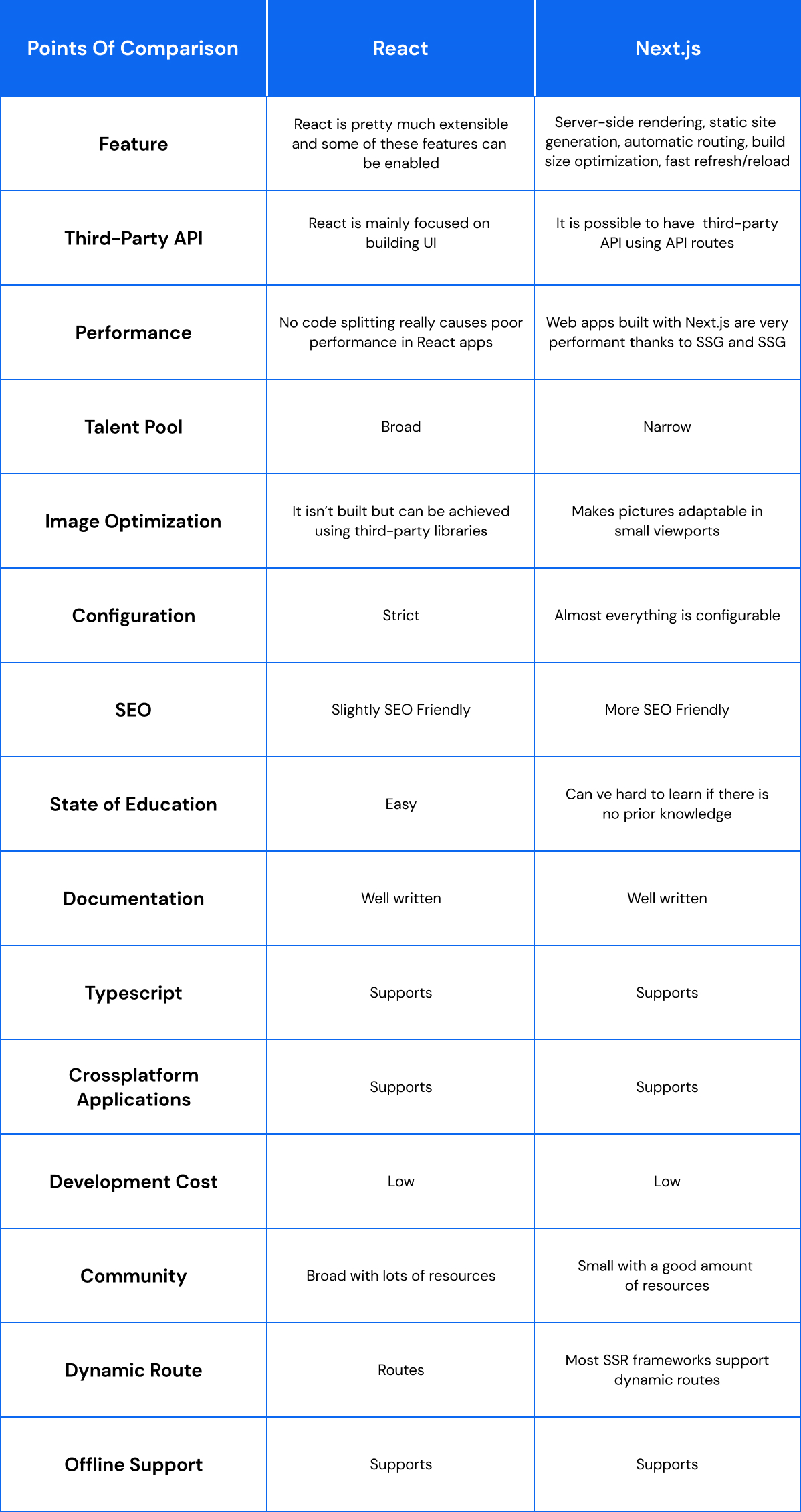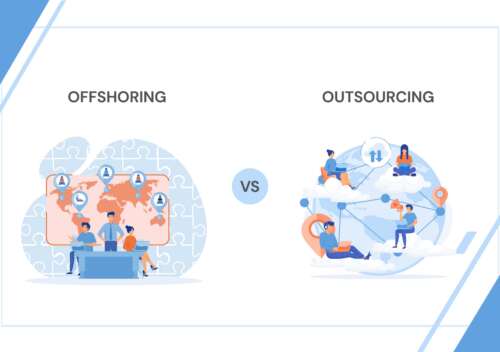For developers, the convenience of using a framework is one of the most important concerns that they look for while developing a software development solution. The article explains the ins and outs of Next JS Vs React battle.
Next.js is trending. That’s how evolving technologies knock on the door and become the talk of the town. The next trending topic in the technology hemisphere is the battleNext.js vs React. The blog will be shedding a light on the differences between these frameworks with an aim to offer you insightful details.
Here is a roundup of the headlines under this blog:
- Introduction to Next.js and React
- Difference between React and Next JS
- Advantages and disadvantages of both frameworks
- Features of both frameworks
- A brief on use cases of React
- A brief on use cases of React
- Pick the JS framework that works the best for you
The software development realm is a forever-changing space. As new technology evolves, the development trends change. Moreover, upgrade in technology does create a shift in software development solutions that companies offer to clients.
As we are focused on the Next JS Vs React framework battle, the blog will cover all the points of difference, pros and cons, and the use cases of both frameworks.
Advancements in framework are a major concern for developers as they need to remain updated with every new thing happening in the related sector. For developers, it is also important to know everything about a framework before considering it for a new project. That makes it essential to choose frameworks that are ideal for work and can help in effortless coding for software developers.
Let’s begin the introduction to Next js vs React
Netx.js is becoming one of the popular frameworks in the React world. Being a simple development environment, Next.js has a learning curve that is easy to explore even for new software developers. Therefore, developing projects with Next JS provides a unique experience in the Next JS Vs React battle.
React, on the other hand, being a JavaScript library has other bunch of benefits for a software development company. The article will further discuss the pros of React separately.
Difference between Next JS vs React
React and Next.js differ from each other on a number of approaches. Here is a brief of the differences between both frameworks.
-
Server-side rendering (SSR)
There is built-in support in Next.js for server-side rendering, meaning the initial rendering is done over the server and the resulting HTML is sent to the clients. This helps improve the SEO part of the website, which is always beneficial.
React, on the other hand, has a client-side rendering approach, meaning it’s the client side where rendering happens first. The process uses JavaScript for rendering web pages, where the server sends the initial HTML file after which clients use JavaScript to update web pages, dynamically.
-
Static Site Generation
Static site generation has Next.js support. The process includes HTML page pre-rendering at the time of building them. The approach is good for websites that have static content as it does not change frequently.
For React, there is no such support for static site generation. This means to get similar backing; the support should be taken from the outside.
-
Automatic Code Splitting
With Next.js, the code splitting happens automatically into smaller chunks. This allows faster page loads and the performance gets better too ensuring the code splitting is done properly.
For automatic code splitting in React, there is an external manual configuration required to obtain this benefit. The lack of built-in support in React gives an additional point to Next.js.
-
Routing
Next.js has a simple routing. This makes it easier to offer a software development solution. This also makes it easier for the developers to handle varied routes and page transitions.
In React, the routing capabilities are not built-in and therefore require routing support from external sources. There are external libraries that your technology partner can use for routing functionality. External functionality like React Router can be used for embedding this functionality.

Advantages and disadvantages of Next JS vs React
Advantages of Next.js:
-
Speed
As explained above, Next.js supports server-side rendering and static site generation. Both processes are fast, which results in web pages being pre-rendered and served. With server side rendering the benefit that comes along is pages are already built on the server and not on the client-side saving a major chunk of time.
-
Easy to create back-end
With Next.js, it becomes easier to create the back-end functionalities that are important to power the functions of the front-end of any website. This makes tasks easier for every software development company and does not affect the size bundle of applications.
-
Built-in CSS support
Built-in CSS support is one of the most impressive features of Next.js, which makes it effortless for website development companies to include CSS stylesheets with every Next.js project without the need to add a library for a similar feature.
-
Less external functionality required
In Next.js, most of the features are inbuilt, which ensures that no external support is required when adding any additional features. The built-in functionalities ensure that developers don’t need to look for external support, which again saves time for them.
Disadvantages of Next.js
-
Development and maintenance
Developing Next.js projects requires a technology partner who is aware of the latest technology and knows how to offer maintenance services. This will also require the support and dedication of an ongoing resource, which is a whole new investment for every software development company.
-
Routing system cost
The routing system of Node.js is helpful for software developers, but it includes a considerable cost. Additionally, by coupling routing logic to different pages on the website, it gets heavier and thus is difficult to maintain as well. This gets even more difficult when there is a requirement of hanging routes frequently.
-
Community
Next.js doesn’t have the support of a robust community as it is with other frameworks. Without the support of a strong community, it sometimes gets difficult to find answers to most of the issues that developers offer as part of their website development services.
Advantages of React
-
Ease of learning
The framework React has grown really well and also offers ease of use to every new learner. The framework is supported by a strong community, making documentation available for every new software developer. There is documented evidence for developers working on a problem for the very first time along with tutorial videos for effortlessly completing any task.
-
Reusable Elements
With React, software developers have the capability to create reusable elements like user interfaces that can be used again and again. The self-contained units of code created with React can easily be reused throughout the application. This makes it easy to create and maintain applications with ease.
-
SEO friendly
React.js is popular for its speed and performance along with its SEO-friendly nature because it easily renders on server side. This means the content first renders on the server side before it is sent to the clients. This ultimately helps to improve the SEO performance and optimisation capability.
-
Enhanced performance
The performance of the React framework is one of the most impressive attributes of the framework. This helps in making React applications fast as well as responsive for the users. In addition to this, React is easy to use with other libraries and frameworks.
Disadvantages of React
-
Tough documentation
React documentation is essential for budding developers to read and learn how to use libraries. However, as the framework is growing in order to help every software development company, the documentation is becoming difficult to navigate. Moreover, as new functionalities are being added to the framework, the documentation still remains outdated.
-
Fast development
The popularity of React has grown in recent years. As the development aspects are changing rapidly, it has become really difficult for software developers to keep up with the required pace. This states that developers need to spend a lot of their valuable time learning and understanding the latest improvements.
-
Re-rendering
There could be unnecessary re-rendering sometimes with the React framework. React components check for change and re-render it every time an unexpected change occurs due to JavaScript’s nature of handling comparisons. This adds to the development time for the developers.
Features of Next.js
Next.js has a number of impressive features to utilise as a software development solution. Following is a brief on the most important features.
-
Image optimisation
In order to help with picture optimisation, Next.js has built-in performance. The feature helps to resize images automatically in order to suit the screen size. This helps developers to optimise images effortlessly. With Next.js, there is an inbuilt loading snipper to help improve users’ experience.
-
Typescript support
Typescript being a superset of Java helps to add type-checking and other features in order to improve the quality of codes. However, Typescript is not required with Next.js, it still is a valuable tool that helps in the improvement of the code.
-
API route
In order to create APIs, there is a built-in feature called API route with Next.js. with these routes, it becomes easier for software development companies to handle incoming requests by creating endpoints. The API routes can also be used for creating a custom backend for another Next.js application.
Features of React
-
Component
React is a combination of components. When multiple react components are coupled together, they create a simple user interface for every complex UI. Each component in this combination has its own logic and behavior as well. These components are easy to use in various other web part pages.
-
One-way data binding
Data binding in React.js is the connection flow between the data that is displayed and the logic component. One-way data binding is the term associated when data flows from the parent component toward the child component. This is a simple way of data flow, which can become complex sometimes.
-
Virtual DOM
Virtual DOM is an example of actual or original DOM. The React team has created another instance of actual DOM with JavaScript. It is fast and in event of any changes, the virtual DOM compares it with another new DOM. In case, both DOM are equal, the actual DOM is not touched and gets updated.
A Brief on Use Cases of React
Below are a few examples of the best use cases of React
React is most popularly used by:
- Netflix, YouTube and other streaming platforms
- Delivery platforms like Uber
- SaaS tools including Zapier
- Social media platforms including Facebook, Instagram
A Brief on Use Cases of Next.js
Below are a few examples of the best use cases of Next.js
Next.js is most popularly finds its use in:
- Marketing websites generally use websites created with Next.js
- Blogs websites
- Landing pages
- E-commerce stores
Pick the JS Framework that Works the Best for You
Next.js capability of server-side rendering makes it one of the most popular and used frameworks for offering web development services. React, on the other hand being a front-end JavaScript library helps developers create reusable components.
Both frameworks have their pros and cons as shown in this article here. Moreover, when it comes to choosing the right framework for your next project, it is the requirement of that particular project, which will help in determining the most suited framework.
Additionally, the selection of the right framework between Next.js vs React also depends on the problem that you would like to solve with the software solution. The solution should also have all the capability and functionality to perform the intended task.



